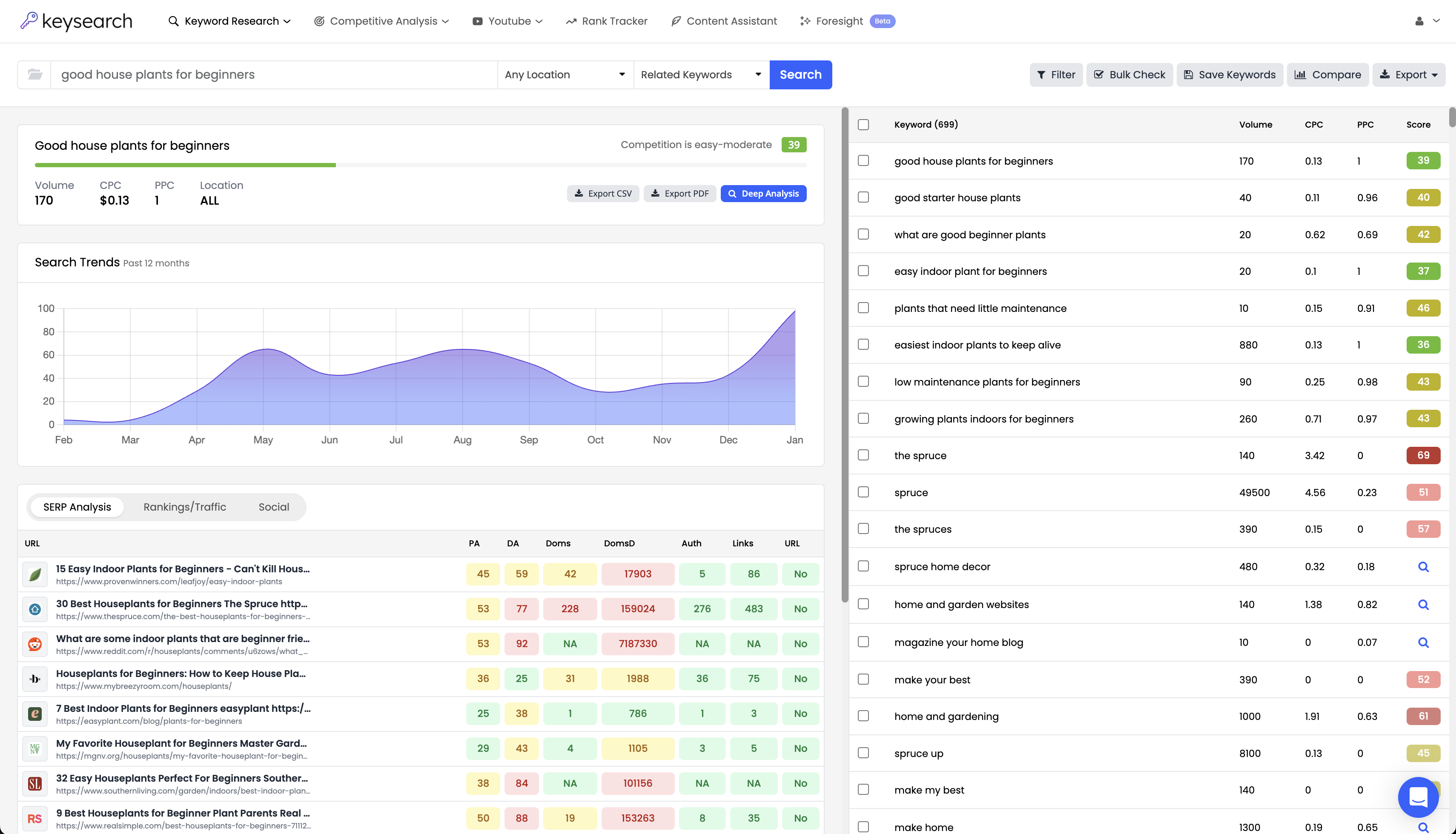Etsy can be a powerful way to attract customers to your offerings, leveraging the platform’s vast user base to get your products in front of millions of eyeballs.
However, tapping into this opportunity requires a meticulous approach to SEO – or search engine optimization. You need to know what your ideal customers are searching for on Etsy and ensure your listing is optimized accordingly.
We have a detailed guide on how to do Etsy keyword research, but we want to look at something more specific today – Etsy long-tail keywords.
Wait, what is a long-tail keyword on Etsy? Why are these so important? As the name suggests, these are longer variations of your primary keywords that users are searching for. They’re more specific, and in this sense, more likely to convert into sales.
Learn how to find long-tail keywords for Etsy below along with tips on optimizing your listings to harness the full power these possibilities present. With our Etsy keyword tool, you can effortlessly open the floodgates to free traffic for your listings!
What is a Long Tail Keyword Etsy?
So, what is a long-tail keyword on Etsy? As we briefly touched on above, these are specific, detailed phrases that potential customers use when they’re closer to making a purchase. They’re also commonly used by customers conducting a voice search.
Unlike short, broad keywords like “candles,” long-tail keywords are more descriptive and often include more than three words. For instance, a shopper might search for “handmade soy candles with lavender scent.”
Other examples of Etsy long-tail keywords include “vintage leather handbag for women,” “personalized name necklaces in gold,” or “custom pet portrait watercolor.”
Why Etsy Long-Tail Keywords Are So Powerful
As you start looking into long-tail focus keywords on Etsy you’ll quickly discover the search volume is far lower compared to broad keywords. So why bother?
Simple – the goal with SEO is to drive conversions, not traffic just for the sake of traffic. Long-tail keywords convert at a far higher clip. It makes sense when you think about it. Someone searching for wedding invitations may not have a specific idea of what they want, they’re still higher up in the buying funnel conducting research.
But, someone who searches for “customizable wedding invitations with pink floral design” has no doubts about what they want to buy – they just need to find someone who offers it!
Beyond the conversion rate benefits, these long-tail variations are simply more attainable given their lower competition. Broad keywords like “jewelry” or “art” are highly competitive, making it difficult for individual sellers to rank on the first page of search results.
Long-tail keywords, however, give smaller sellers a better chance to appear in top search results. This visibility leads to more clicks and, ultimately, more sales.
Conducting Etsy SEO takes up quite a bit of time and resources. So many sellers end up spinning their wheels, failing to actually see results from their efforts.
By focusing on Etsy long-tail keywords you can start to see quick wins. So, let’s get into how to find long-tail keywords for Etsy so you can see firsthand how powerful they are!
How to Find Long Tail Keywords for Etsy
The basic principles of finding Etsy long-tail keywords are no different than finding long-tail keywords for any other platform. So if you’re also selling on other platforms, you can follow the same advice. It all starts with a seed keyword.
Start With a Seed Keyword
If you don’t already have a seed keyword for your item, that’s ok – you can simply head over to the Etsy search bar and plug in what you think closely aligns with your product.
Once the results populate you can take a look and see if the products that come up are similar to what you’re selling. Then, filter through competitors and see what keywords they are using.
Most of the time finding a seed keyword will just require some common sense.
Plug it Into Our Etsy Long Tail Keyword Generator
Our long tail keyword generator makes it easier than ever to find Etsy long-tail keywords. The best part? It’s entirely free to start with!
It’s unlike any other solution in that we actually pull our data from Etsy’s own auto-suggest feature, which means you’re getting the most accurate information possible to set yourself up for success. We supplement the data with insights from other search engines as well.
You can navigate to our keyword research tool and set your criteria to pull from “Etsy suggest” data. Then, set the filter to require a certain number of words – at least 3 to find legitimate long-tail variations. There are plenty of other filters you can play with too, like words to exclude, volume, difficulty, etc.
For example, we typed in “handmade earrings” and set the minimum word filter to 3. Here were some opportunities that came up:
- Handmade earrings clay
- Handmade earrings gold
- Handmade earrings silver
- Handmade earrings in leather
- Handmade earrings beaded
You can start to add keywords to a list, and from there, we’ll get to refining them.
Apply Criteria for Difficulty and Search Volume
Not every long-tail variation will be a good candidate for your Etsy store. In fact, many won’t be. You need to start by reviewing the list to see which are the most relevant.
Think back to our example above – if you only sell handmade earrings made from gold or silver, then the other material variations won’t make sense (unless you want to expand your offerings!).
Relevancy is the most important thing to consider when mapping out Etsy long-tail keywords. You’ll rarely be able to rank for something that doesn’t align with what you’re selling – the Etsy algorithm is sophisticated enough to only offer the right suggestions for its customers.
But even if you do rank, you’re not going to match the searcher’s intent – there’s no point.
Next, use our keyword difficulty tool to uncover the hidden gems that are going to be easy to rank for. What is a good keyword difficulty score, you ask? We suggest setting your criteria to only show those under 30. You could also look at CPC as a difficulty metric.
The good news is that most of the keywords you uncover are going to be low-difficulty, as this is a distinct characteristic of long-tail keywords in general.
Of course, you want to ensure ample search volume for the keywords as well. Keywords with higher search volumes indicate more interest and potential traffic. However, it’s essential to balance search volume with relevance and competition.
Don’t be afraid to target keywords with a difficulty between 0-50. If the tool uncovers a keyword, that means people are actively searching for it. Our experience has shown that most of the time, search tools underestimate how many people are actually searching for something.
Other Methods for Uncovering Etsy Long-Tail Keywords
At this point, you should have a solid list of long-tail focus keywords on Etsy that align with your products. We’ll talk about what to do after keyword research next. But before we do that, let’s look at how to find long-tail keywords for Etsy in a few other ways:
- Use Etsy’s Search Bar: Start typing your seed keyword and observe the autocomplete suggestions. These are based on popular searches and can provide insight into what shoppers are looking for.
- Analyze Competitor Listings: Look at the top listings for your seed keywords and analyze the keywords they use in their titles, descriptions, and tags. Competitors who rank well for your seed keywords are likely using effective long-tail keywords. You can do this manually, or you can use our competitor analysis tool in Keysearch to streamline the process.
- Leverage Google Trends: Use this tool to find out which long-tail keywords are gaining popularity and when they might be most effective, such as around certain holidays or seasons.
- Explore Forums and Social Media: Pay attention to the language and questions used by participants to uncover popular long-tail keywords and customer pain points.
- Check Etsy’s Related Searches: These live at the bottom of Etsy search results and unveil additional long-tail keywords that shoppers frequently use.
- Pull Etsy Ads Data: If you’re running sponsored ads on Etsy, you can pull your data and see which specific terms are converting for you. Chances are, you’ll be greeted by some long-tail variations of your seed keyword you hadn’t even thought of. You can incorporate these in your listing and start driving sales organically, boosting profits.
There are so many different ways you can go about finding Etsy long-tail keywords, but with the best free SEO tools just a click away, why work harder? You can work smarter with Keysearch and learn how to automate keyword research today.
Optimizing Etsy Listings With Long Tail Keywords
After going through our keyword research checklist your next steps are optimizing your listings to start turning these opportunities into sales. Here’s how to create optimized listings:
Crafting Optimized Product Titles
Your product title is the most important element for telling Etsy’s search algorithm what you sell. Start with your primary long-tail keyword, but ensure it reads naturally and clearly. Mention the material, color, size, and any unique aspects.
While it’s important to include keywords, avoid stuffing them unnaturally. A title that’s overloaded with keywords can be off-putting to potential buyers and may even be penalized by Etsy’s algorithm.
Writing Detailed and Keyword-Rich Descriptions
Your product title gets someone to click through to your listing – this is where you actually sell them on your item.
Start your product description with the most important details, including keywords. This not only helps with SEO but also ensures that buyers immediately see the key features of your product.
Sprinkle in secondary keywords naturally throughout. For example, if your primary keyword is “custom wedding invitations,” secondary keywords might include “vintage wedding invites” or “personalized wedding stationery.” Our LSI keyword tools can help you uncover these.
Engage your potential buyers by telling the story behind your product. Explain the inspiration, the making process, and the benefits. We’re working on a product description generator now that will help streamline this process for you – stay tuned!
Utilizing Tags and Categories
Tags are a great way to clearly display what your product is and who it’s for. Fill out all 13 tags available with long-tail keywords. Think about what your customers might type into the search bar.
Similarly, you need to select the most accurate categories for your listings. This helps Etsy match your products with relevant searches, increasing the chances of your items being discovered by the right audience.
Enhancing Image Metadata
It’s no secret that quality images can make or break your success on Etsy. But, beyond the resolution, be sure to optimize your image meta data for search as well.
When uploading product images, rename the files to include your primary keyword. Instead of “IMG1234.jpg”, use “handmade-sterling-silver-earrings.jpg.” Fill out image descriptions too.
Utilizing Backend Keywords
Etsy allows you to add keywords that aren’t visible to buyers but help with search ranking. Use this space to add additional long-tail keywords that didn’t fit naturally into your title or description. Think about common misspellings or different terms customers might use.
Tracking Rankings Over Time
While most of the hard work is done at this point you need to set up rank tracking either within Etsy or in a tool like Keysearch. This helps you get a sense of how your efforts are paying off.
Give the changes you make a few weeks before you make any adjustments. Only change one thing at a time so you can associate ranking fluctuations with each specific change.
Hopefully, these tips help you make the most of long-tail focus keywords on Etsy. You can also use our keyword clustering tool or keyword density tool to assist with listing generation.
Or, read through our top keywords list and see if we’ve already curated opportunities for your specific niche! We also have an Amazon keyword generator, eBay keyword research tool, Pinterest keyword research, YouTube keyword research tool, duplicate content checker, and more.
So, what are you waiting for? Set yourself up for Etsy SEO success today.
Parting Thoughts on Etsy Long-Tail Keywords
So, what is a long-tail keyword Etsy? In summary, these are essential for boosting your Etsy shop’s visibility and attracting highly targeted customers.
By using specific phrases, you can reach buyers who are closer to making a purchase, face less competition, and improve your SEO. Now that you know how to find long-tail keywords for Etsy, it’s time to get to work!
You can find more tips on how to do Pinterest keyword research or how to do keyword research for YouTube. We also have resources comparing our solution to the field:
But, we’ll save you the time – you won’t find a better SEO toolkit than the one awaiting you here at Keysearch. You get 12 powerful tools with more in the works, many of which are free or highly affordable.
With the trust of Shopify, Ezoic, Mediavine, Search Engine Journal, and more, you can rest assured you’re equipping yourself with the right tools. Don’t just take our word for it – try it free today!
- How to Do Keyword Research for Free: Best Free Keyword Research Tools in 2024 - December 13, 2024
- Benefits of Keyword Clustering: Why is it Important to Group Relevant Keywords Together? - December 13, 2024
- What is Keyword Density in SEO and Its Importance - December 13, 2024







